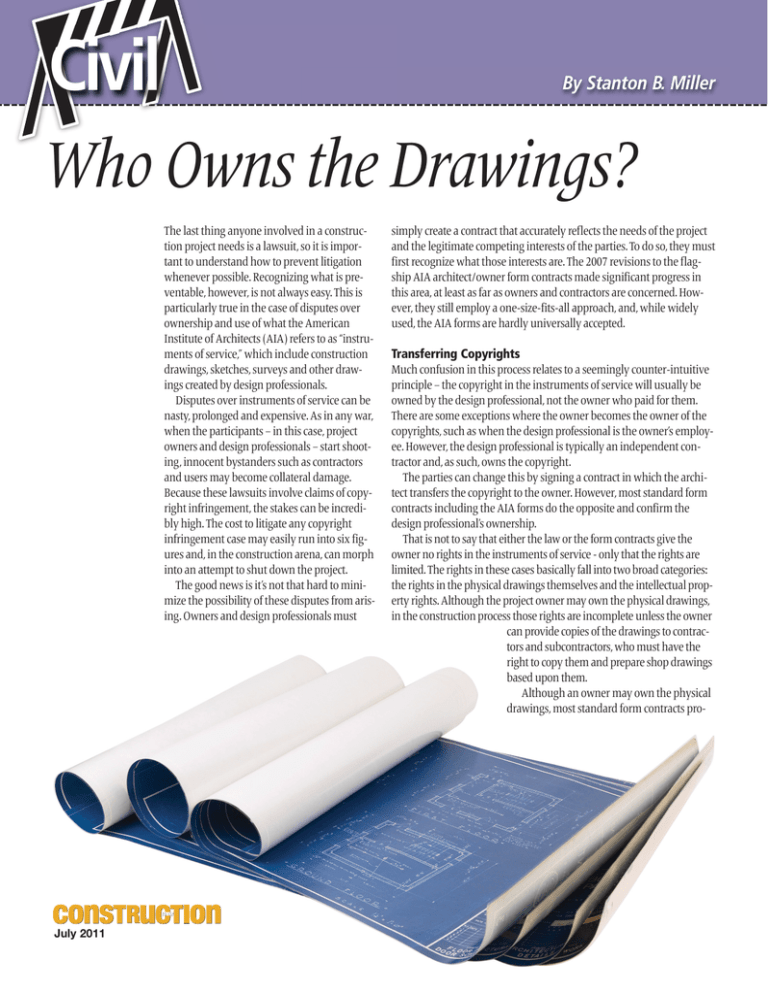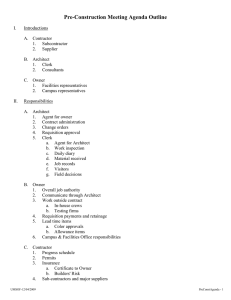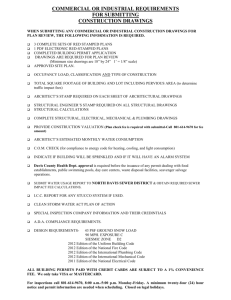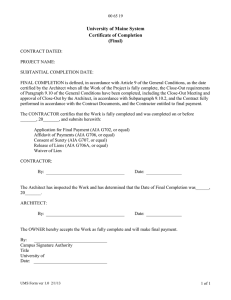
Civil
By Stanton B. Miller
Who Owns the Drawings?
The last thing anyone involved in a construction project needs is a lawsuit, so it is important to understand how to prevent litigation
whenever possible. Recognizing what is preventable, however, is not always easy. This is
particularly true in the case of disputes over
ownership and use of what the American
Institute of Architects (AIA) refers to as “instruments of service,” which include construction
drawings, sketches, surveys and other drawings created by design professionals.
Disputes over instruments of service can be
nasty, prolonged and expensive. As in any war,
when the participants – in this case, project
owners and design professionals – start shooting, innocent bystanders such as contractors
and users may become collateral damage.
Because these lawsuits involve claims of copyright infringement, the stakes can be incredibly high. The cost to litigate any copyright
infringement case may easily run into six figures and, in the construction arena, can morph
into an attempt to shut down the project.
The good news is it’s not that hard to minimize the possibility of these disputes from arising. Owners and design professionals must
July 2011
simply create a contract that accurately reflects the needs of the project
and the legitimate competing interests of the parties. To do so, they must
first recognize what those interests are. The 2007 revisions to the flagship AIA architect/owner form contracts made significant progress in
this area, at least as far as owners and contractors are concerned. However, they still employ a one-size-fits-all approach, and, while widely
used, the AIA forms are hardly universally accepted.
Transferring Copyrights
Much confusion in this process relates to a seemingly counter-intuitive
principle – the copyright in the instruments of service will usually be
owned by the design professional, not the owner who paid for them.
There are some exceptions where the owner becomes the owner of the
copyrights, such as when the design professional is the owner’s employee. However, the design professional is typically an independent contractor and, as such, owns the copyright.
The parties can change this by signing a contract in which the architect transfers the copyright to the owner. However, most standard form
contracts including the AIA forms do the opposite and confirm the
design professional’s ownership.
That is not to say that either the law or the form contracts give the
owner no rights in the instruments of service - only that the rights are
limited. The rights in these cases basically fall into two broad categories:
the rights in the physical drawings themselves and the intellectual property rights. Although the project owner may own the physical drawings,
in the construction process those rights are incomplete unless the owner
can provide copies of the drawings to contractors and subcontractors, who must have the
right to copy them and prepare shop drawings
based upon them.
Although an owner may own the physical
drawings, most standard form contracts pro-
IN THIS SECTION
vide that the owner can use them for a limited purpose. The 2007 AIA
B101 owner architect agreement, for example, provides that the owner
may use the drawings to complete, maintain and alter the project as
long as he pays the full amount due to the architect. This is far better for
owners than the 1997 version of the AIA form contracts, which provided
that the owner, who paid for the drawings, received a right to use them
to complete the project but not the right to use them for additions.
Ames Construction
Inc. g p. 114
Analyzing Needs
Guam International
Airport Authority
While the rights in the 2007 AIA and similar forms may be sufficient in
most cases, none of the major standard forms give the owner the rights
to use the instruments of service on other projects. Furthermore, while
the AIA forms provide that the owner may terminate the services for
“convenience,” the owner must pay the architect a license fee “solely for
the purpose of completing, using and maintaining the project.” The
amount of the fee is left blank, and it is not unusual for the parties to fail
to insert any number in the blank provided. Sometimes the omission is
inadvertent, and in some cases results because the parties fail to agree
on the amount of the fee. If they can’t reach agreement while negotiating a contract, there may be little chance of reaching an amicable agreement after the owner has terminated the architect’s service.
Note that when the owner terminates for convenience, the form omits
the owner’s right to use the drawings for renovations to the same project. In many projects, the owner will not want to forgo that possibility.
All these rights are predicated on the owner making full payment to the
architect under the contract.
Before executing a form contract, owners and architects should analyze their respective needs to determine if they are being met by the
form they chose. For example, most form contracts will not meet the
needs of an owner who plans to use the drawing for a rollout of similar
structures, such as chain restaurants or retail operations.
The form contract limits the owner’s use to the one project that is the
subject of the contract. If the owner plans to use those drawings as a
prototype on other projects, he needs to make sure the contract includes the necessary rights. The owner may have to pay an additional
fee to the architect for this, and the owner has more leverage to negotiate that fee before signing the contract than after the architect completes his services.
An owner contemplating a signature building will be deeply disappointed if the architect constructs its twin for someone else – think of
two buildings looking like the Guggenheim in close proximity. Since the
form contract provides that the architect owns the copyright in the
drawings, he can do whatever he wants with them. Again, the owner
must evaluate his needs and make sure those needs are met by the
signed contract.
Avoiding Problems
An owner can avoid all of the problems I’ve described with one simple
change. If the contract provides that the owner, not the architect, owns
the copyright in the instruments of service, the owner can do with them
as he sees fit. While many architects will object, sometimes the payment
Ames is getting the word
out about the Milton E.
Proby Parkway project.
g p. 128
The Authority is ready for
an increased population.
Company Profiles
114 Ames Construction Inc. – Milton
E. Proby Parkway
118 Munilla Construction Management
LLC – Miami International Airport
122 RoadSafe Traffic Systems Inc.
126 Flatiron Construction Corp.
128 Guam International Airport
Authority Capital Improvement
Program
of an additional fee will remove the objection.
Some architects will require the payment of
the entire fee before the copyright passes to
the owner. This is a reasonable request since it
provides the architect with additional assurance that the owner will pay for services rendered. In addition, the architect will generally
want the contract to reflect that the architect
will incur no liability when another architect
uses his or her drawings.
The key is for the parties to recognize the
issues, get them on the table and comprehensively deal with them. Unfortunately, this
sometimes doesn’t happen until the parties
are disenchanted with each other and amicable agreements are hard to reach.
STANTON B. MILLER is a partner in the law firm of Ungaretti & Harris, based in
Chicago. As a construction and intellectual property attorney, Miller has negotiated construction contracts for a wide variety of projects including factories, hospitals,
museums and hotels. He also represents clients in construction-related disputes. He
can be reached at 312-977-4395 or sbmiller@uhlaw.com.
Published by Business Media Publications Ltd. Tel: 312.236.4090 Fax: 312.236.4266
On behalf of Ungaretti & Harris © 2011 Business Media Publications Ltd. All rights reserved.




